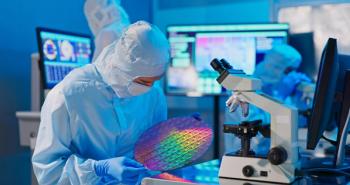
- Spectroscopy-07-01-2020
- Volume 35
- Issue 7
Multicollector ICP-MS and Isotope Metallomics
Although not as widespread in terms of units used worldwide as quadrupole-based inductively coupled plasma–mass spectrometry (ICP-MS) equipment, also multicollector ICP-MS (MC-ICP-MS) instrumentation has revolutionized many fields.
Although not as widespread in terms of units used worldwide as quadrupole-based inductively coupled plasma–mass spectrometry (ICP-MS) equipment, also multicollector ICP-MS (MC-ICP-MS) instrumentation has revolutionized many fields. An MC-ICP-MS system is a dedicated tool for high-precision isotopic analysis of metals, metalloids, and some non-metals. For that purpose, an MC-ICP-MS instrument is equipped with a double-focusing mass spectrometer of Nier-Johnson geometry and an array of detectors, typically Faraday cups, for simultaneous monitoring of the intensities of the ion beams of interest (Figure 1).
The first MC-ICP-MS unit was introduced onto the market in 1992 (1). Compared to thermal ionization mass spectrometry (TIMS), which was the “gold standard" for isotope ratio measurements at the time, MC-ICP-MS offered much more “measurement comfort.” For an adequate TIMS measurement, the element of interest has to be isolated from the matrix and deposited in elemental form or in the form of a salt on a metal filament. If the isolate is not pure enough, the signal intensity will be very low at best. The metal filament then needs to be resistively heated in a vacuum chamber for ion production. In contrast, in MC-ICP-MS the robust ICP ion source is generated under atmospheric pressure, thus allowing sample introduction by means of continuous nebulization.
One disappointment with MC-ICP-MS was the awareness that although ionization efficiency remains high irrespective of the concomitant matrix, reliable isotope ratio data typically also require the target element to be isolated. This is a result of the occurrence of instrumental mass discrimination, according to which the ions of the heavier of any two isotopes are transferred more efficiently from the ion source to the detector than those of the lighter one. Compared to the measurement precision of ±0.001% RSD under ideal circumstances, the bias induced by instrumental mass discrimination is horrifically large at ≈1% per atomic mass unit (amu) at mid-mass and even larger at low masses (such as for Li and B). The matrix has a profound influence on the extent of mass discrimination and thus, it was realized that with MC-ICP-MS acquiring reliable results required intensive sample preparation in the form of (chromatographic) element isolation as well. But even this approach is not sufficient, because the analyte concentration itself has also been seen to affect the extent of instrumental mass discrimination. Hence, all sample and standard solutions have to be concentration-matched and while “within ±30%” was a generally applied rule of thumb, recent papers testify of more stringent conditions such as “within ±5%”. This situation is the result of the introduction of high-efficiency interfaces, improving the analyte transport efficiency, but making the instrumentation more sensitive to differences in the composition of the solution measured, and the fact that the analytical community is addressing ever more challenging applications, involving lower target element concentrations or smaller differences in their isotopic composition, or both. Nevertheless, under these conditions, a combination of an external standard (a standard of the target element with known isotopic composition) measured in a sample-standard bracketing approach and an internal standard (a standard of an admixed element close in atomic number to that of the target element with known isotopic composition) provides adequate correction.
So, it turned out that it was not a more lenient sample preparation that was to be the most striking advantage of MC-ICP-MS, but the vastly higher ionization capabilities. While TIMS struggles to produce M+-type ions for elements with an ionization energy exceeding 7–7.5 eV, the ICP succeeds in converting even non-metals into M+-ions with an efficiency permitting their isotopic composition to be studied. Moreover, sample throughput also could be increased dramatically compared to TIMS. And both these features had important practical consequences.
The most prominent area that has been revolutionized by the newly available capabilities of MC-ICP-MS is most probably that of geo- and cosmochemistry. But nuclear applications (including provenance determination of environmental contamination) have also profited from the opportunities offered by MC-ICP-MS, as have many other research fields. Access to information on the isotopic composition of Hg, which shows natural variation as a result of both mass-dependent and mass-independent isotope fractionation, thus providing complementary information, for example, has already led to a wealth of information on the element's biogeochemistry and to insights that would not be obtained based on Hg concentrations only (2). The realization that all elements with two or more isotopes show natural variation in their isotopic composition due to isotope fractionation effects accompanying physicochemical processes, most of which can be revealed and quantified with MC-ICP-MS, has led to many areas of application of this technique.
One application field of MC-ICP-MS that is still less exploited is high-precision isotopic analysis of essential mineral elements in a biomedical or clinical context. Personally, I got attracted to this field by the seminal 2002 Walczyk and von Blanckenburg paper in Science that reported a difference in the whole blood Fe isotopic composition between male and female individuals. That paper made it clear that isotope fractionation also accompanies biochemical processes and that the isotope ratios of essential mineral elements in body fluids and tissues do hold a message (3). After further exploration, it was realized that such high-precision isotopic analysis can be exploited to obtain a more profound insight into the role of metals in biochemical processes, and that isotope ratios could perhaps also serve as markers, allowing diagnosis of diseases that could otherwise only be established at a later stage or via a more invasive approach, or both (4). This approach is sometimes called isotope metallomics. Initially, this field was explored by only a few groups worldwide (including mine at Ghent University). Because the instrumentation needed was predominantly present in geochemical laboratories, several of these pioneering groups have that background. This has led to terms like “geomedical” sciences that (at least in my view) are not only misleading, but may even alienate researchers with a biological or medical background from this new field.
Key findings over the past couple of years include the observations that the disease activity of multiple myeloma is reflected in the serum Ca isotopic composition (5); that the isotopic composition of elements like Cu and Zn may show a different isotopic composition in tumoral tissue than in adjacent healthy tissue (6); and that the whole blood or serum Fe isotopic composition is a good measure for an individual’s iron status, also in disease conditions in which the parameters normally used for this purpose are corrupted (7). Increasingly more diseases, also including neurodegenerative disorders (8) and diabetes (9), are shown to be reflected in deviating metal isotope ratios in biofluids, even when the corresponding element concentrations are not affected (Figure 2).
Based on convincing results, increasingly more research groups are developing an interest in this field that has meanwhile also aroused some attention from the medical community. After a rather exploratory phase, the question about the factors driving changes in isotopic composition is voiced increasingly louder and therefore, the studies reported in publications have generally changed from more exploratory to more targeted research. Answering the question of what exactly MC-ICP-MS can contribute to the medical and clinical field will require very substantial and truly interdisciplinary research efforts, combining theoretical calculations, in vitro experimental work (with cell lines and tumor spheroids) and in vivo experimental work with animals.
Further instrument development to extend the capabilities in this context also would be highly welcomed. I would, for example, highly appreciate a setup for spatially resolved isotopic analysis of biological tissue offering both the spatial resolution and the isotope ratio precision needed. While I believe that, at the sampling site, the laser ablation (LA) equipment is already there (10), the MC-ICP-MS detection system still struggles with very fast transient signals. To have success in an actual clinical context, sample throughput also would need to be enhanced. Most papers on the topic of “isotope metallomics” reporting on human samples deal with a relatively limited number of samples (typically <50). This often prevents acceptance of the work in medical journals, because the medical community is used to studies involving substantially higher numbers of individuals. To some extent however, such decisions overlook the precision with which MC-ICP-MS can document small changes and the systematic nature of the latter. But also, if ever adopted in clinical routine, sample throughput must be higher and that should be an incentive to think out of the box and explore alternative or “lighter” sample preparation protocols or even simplified dedicated instruments.
Whatever the future of isotope metallomics, I am still as intrigued as I was when I first read the Science paper mentioned above. My group will continue researching this issue with great enthusiasm.
References
- A.J. Walder and P.A. Freedman, J. Anal. At. Spectrom. 7, 571–575 (1992).
- J.D. Blum, L.S. Sherman, and M.W. Johnson, Ann. Rev. Earth Planetary Sci. 42, 249–269 (2014).
- T. Walczyk and F. von Blanckenburg, Science 295, 2065–2066 (2002).
- M. Costas-Rodríguez, J. Delanghe, and F. Vanhaecke, Trends Anal. Chem. 76, 182–193 (2016).
- G.W. Gordon, J. Monge, M.B. Channon, Q. Wu, J.L. Skulan, A.D. Anbar, and R. Fonseca, Leukemia 28, 2112–2114 (2014).
- F. Albarede, P. Télouk, V. Balter, V.P. Bondanese, E. Albalat, P. Oger, P. Bonaventura, P. Miossec, and T. Fujii, Metallomics 8, 1056–1070 (2016).
- Y. Anoshkina, M. Costas-Rodríguez, M. Speeckaert, J. Delanghe, and F. Vanhaecke, Metallomics 9, 517–524 (2017).
- L. Sauzéat, E. Bernard, A. Perret-Liaudet, I. Quadrio, A. Vighetto, P. Krolak-Salmon, E. Broussolle, P. Leblanc, and V. Balter, iScience 6, 264–271 (2018).
- R. Grigoryan, M. Costas-Rodríguez, S. Van Laecke, M. Speeckaert, B. Lapauw, and F. Vanhaecke, J. Anal. At. Spectrom. 34, 1514–1521 (2019).
- S.J.M. Van Malderen, T. Van Acker, and F. Vanhaecke, Anal. Chem. 92, 5756–5764 (2020).
Frank Vanhaecke is a senior full professor of analytical chemistry and the head of the Atomic & Mass Spectrometry (A&MS) research group at the Department of Chemistry at Ghent University, in Ghent, Belgium. Direct correspondence to
Articles in this issue
over 5 years ago
Vol 35 No 7 Spectroscopy July 2020 Regular Issue PDFover 5 years ago
Where Spectroscopy Is Headingover 5 years ago
A Further Leap of Biomedical Raman Imagingover 5 years ago
The Future of Portable Spectroscopyover 5 years ago
Light Matters . . . 35 Years of New Sources for Spectroscopyover 5 years ago
Single-Cell Analysis by ICP-MS—Current Status and Future Trendsover 5 years ago
When Size Matters: ICP-MS Detection of Small Objectsover 5 years ago
Atomic $pectroscopyNewsletter
Get essential updates on the latest spectroscopy technologies, regulatory standards, and best practices—subscribe today to Spectroscopy.





